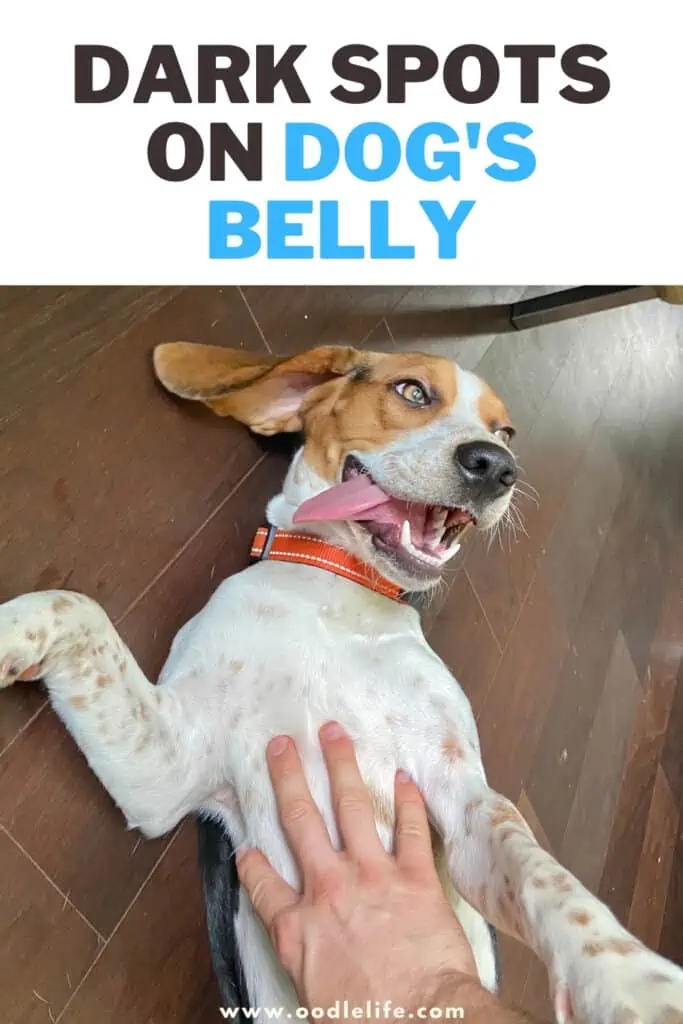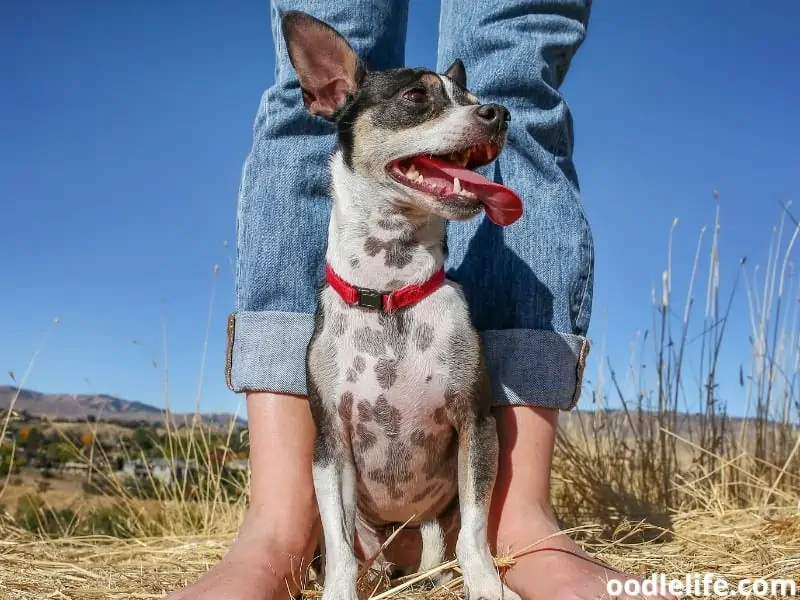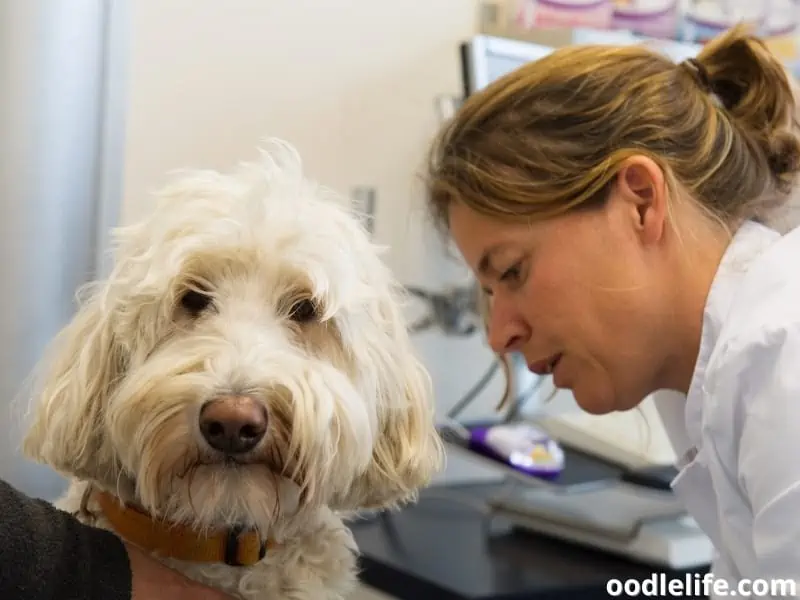How do I get rid of black spots on my dogs stomach

Dark Spots on Dogs Belly [What They Mean]
Youre busy with your pup spending time together, giving it some belly rubs, and you notice a couple of black spots on its tummy. Youll probably start to wonder what the cause behind them is.
Well, black spots are usually due to hyperpigmentation, and there are many causes of this condition. This is why it is crucial to visit a vet if you notice your dog has black spots on its stomach.

Read on to learn everything you need to know about dark spots on a dogs belly.
What Is Hyperpigmentation in Dogs?
Hyperpigmentation is the darkening or thickening of a dogs skin. It is usually visible in lighter and hairless areas of a dogs body, like the groin and the belly.
Its important to understand that hyperpigmentation isnt a disease but a reaction to other conditions affecting a dogs skin. Hyperpigmentation in dogs is usually classified into two types: primary and secondary hyperpigmentation.
This type of hyperpigmentation is quite rare and is known to affect a few dog breeds, such as the Dachshund breed. It typically starts to become visible when a dog is a year old.
Secondary hyperpigmentation is pretty common and is often a result of many factors, such as skin allergies and infections, hormonal abnormalities, obesity, among others.

What Conditions Cause Dark Spots on Dogs Bellies?
As we mentioned earlier, hyperpigmentation is often a reaction or symptom of a particular condition.
Here is a closer look at some of these medical issues that cause dark spots on a dogs belly.
Hypothyroidism
This is a medical condition (more of a metabolic disorder) whereby a dogs thyroid glands are underactive; therefore, they dont secrete enough thyroid hormone. And when a dogs body doesnt have adequate amounts of this hormone, its metabolism becomes slower.
While hypothyroidism affects almost all dog breeds, it is more common in some breeds than others.
Some breeds that are more likely to have this condition include Dachshund, Cocker Spaniels, Irish Settlers, and Doberman.
One of the symptoms of hypothyroidism is hair loss which primarily occurs at the back of the hind legs and the tail. Then, dark spots or patches begin to appear in those areas. However, this condition doesnt cause a dogs skin to get itchy.

Cushings Disease
Also known as hyperadrenocorticism, this is a medical condition whereby a dogs adrenal glands overproduce certain hormones.
Cushings disease is mainly caused by a tumor in the pituitary gland. In rare cases, it may also be caused by giving a dog too much medication, particularly steroids.
This conditions main symptoms are an unhealthy-looking fur coat and dark spots on the skin, especially the belly.
Mange
Mange is a disease caused by mites that comes in two forms: sarcoptic and demodectic mange.
Sarcoptic mange comes from the Sarcoptes scabiei mite, which is the same type of mite that leads to scabies in humans. These tiny spider-like mites burrow deep into the skin, causing intense itching. They are known to mainly target areas with no fur like the belly and armpits.
The extreme itching and licking lead to red rashes, which may later turn to dark spots and loss of fur.
Demodectic mange is caused by Demodex mites and also causes extreme licking and itching leading to open sores which may turn to dark patches. It isnt contagious and usually affects dogs whose immune system is weak.

Yeast Infection
Also known as Malassezia dermatitis, yeast infections in dogs come from a fungus called Malassezia pachydermatis.
Usually, your dogs skin is capable of keeping the numerous fungi and bacteria under control, thanks to its robust immune system.
However, if your animals immune system is suppressed or becomes weak, the bacteria and fungi on its skin may cause a yeast infection. And if the condition is chronic, it may cause your dogs skin to have thick dark or gray patches.
Surprisingly, yeast infection in dogs isnt contagious. But there are some dog breeds that are more prone to developing it. Among them include the Dachshund breed, Silky Terrier, Cocker Spaniel, Australian Terrier, and Chihuahua.
Allergic Dermatitis
Otherwise known as atopic dermatitis, this skin condition is caused by allergens such as food, pollens, plants, and insects.
So, if your dog is allergic to either of these allergens and comes into contact with them, its skin may have an allergic reaction. This may cause it to become extremely itchy, leading to intense scratching, rubbing, and licking, which further leads to redness and tough dark patches.

Flea Allergy Dermatitis
This is a condition caused by flea bites. When a flea sucks on your dogs blood, it injects its saliva into its skin.
A fleas saliva contains peptides, amino acids, and other histamine-like compounds that may trigger an allergic reaction from your dogs immune system. It may cause your pups skin to become extremely itchy, leading to excessive scratching, licking, and rubbing, resulting in sores that turn to dark patches.
Epidermal Hamartoma
Epidermal hamartoma is a type of tumor found on a dogs skin. These dark, pointy bumps are susceptible to secondary bacterial infections if you dont treat them early. This condition is quite rare, affecting only a few dog breeds like the Cocker Spaniel.

How Do I Get Rid of Dark Spots on a Dogs Belly?
The first thing to do if you notice dark spots on your dogs belly is to consult a vet. As we mentioned before, dark patches or spots are a sign of underlying conditions. So, it is best to have a vet check your pet to determine the root cause of the issue.
Do dogs have belly buttons? Find out the surprising truth!
It is important to note that if the hyperpigmentation (dark patches or spots) is primary, it cannot be cured. But, if you notice it early enough, it can be improved through medications like steroid ointments.
Secondary hyperpigmentation is easy to deal with once the cause is identified. For example, antifungal and antibiotic medications can be used to treat yeast infections. Medicated shampoos can be used to alleviate itching caused by flea dermatitis, among other skin conditions, and so on.

Conclusion
Dark spots on a dogs belly may or may not be a cause for concern. If these spots are not itchy and dont come with other symptoms like loss of fur, then your dog may have primary hyperpigmentation.
On the other hand, if these spots are extremely itchy and your pup keeps scratching that area, it might be secondary hyperpigmentation. Again, it is essential to visit a vet to look at those spots to determine the severity of the issue and the proper medication to provide relief for your pet.
Black Spots on Dogs Skin, Belly, Privates & Hair Loss
This post may contain affiliate links. Please read ourdisclosure.
What causes black spots on a dogs skin? Can they be treated or removed? If your dog has black dots on the belly, skin, or near its privates, this article will inform you of effective ways to deal with them.
In this article I will also elaborate on how to deal with crusty scabs or rashes on the skin using shampoos and other chemicals such as Miconazole creams.
My Dog Is Getting Black Spots on her Skin
Dark spots can be stressful for both the dog owners and the dogs. The owners never like to see their dog have any sort of abnormality and seeing dark spots can worry some owners if they dont know what it could be from.

Several dog owners are not aware of the causes of the dogs black spots and might, therefore, fail to find the appropriate remedy to address such black spots issue.
7 Causes of Black Spots on Dogs Skin & Belly
There are several causes of black spots on dogs skin including:
#1 Thyroid deficiency
If you notice that your dog has black spots that are tender to touch and are changing in shape and size. This is an indication that your dog has a thyroid condition. With a thyroid condition, the dog will lose some hair. This then makes the black spots to be more visible.
Hypothyroidism happens when your dog is not secreting enough of the thyroid hormones, causing your dogs metabolism to slow down. This condition is more common in dogs than in other types of domestic animals, but it usually responds well to appropriate medication given by a vet.
#2 Secondary Acanthosis Nigricans
The Secondary type of Acanthosis Nigricans are more common than the primary form of the condition and can affect any dog, regardless of the breed. The disease is caused by friction, which is due to hormonal imbalances, the dogs obesity, or hypersensitivity to food. This disease results in increased black spots in the dogs skin.
#3 Acanthosis Nigricans
Acanthosis Nigricans is an uncommon cutaneous reaction pattern characterized by axillary hyperpigmentation, lichenification, and alopecia.This condition is rare and primarily affects puppies that are less than one year old. Also, the condition usually only affects Dachshund breeds. When your dog is affected by the disease, its skin thickens, and black spots appear on its skin.
#4 Hemorrhage
Hemorrhage is a bleeding condition that is commonly known as vasculitis because of its reference to the blood vessels. When the dog is bruised, the blood capillaries below the skin get ruptured. As the blood comes out, some will be trapped below the skin. This will cause skin discolouration and black spots above the trapped blood.
#5 The Sun
The presence of melanin protects the dog from harmful ultraviolet rays emitted by the sun. The rays are dangerous and can cause dark spots on your dogs belly. If your dog stays away from the harsh rays on extremely sunny days, the dark spots should go away within 1-2 weeks.
#6 Aging
When your dog is old, it develops age spots, which are dark in color.
These dark spots due to age are not harmful, and therefore, individuals are usually advised to know the ages of their dogs in order to rule this type out.
#7 Allergies
When the dog is allergic to some environmental factors, it might show some signs including the appearance of dark spots on the belly.
Black Patches or Scabs on Dogs Skin
Black patches and scabs are different than black spots. They cover a wider area of the skin normally and are all black where spots mostly look like little black circles.
Sometimes the black patches can occur naturally. They can be seen in areas of friction such as legs, and armpits. However, when the dog is allergic to something, you are likely to notice the black patches on their skin.
Therefore, you should watch your dog careful to be able to differentiate between these two types. You could also remove anything new that may have caused allergies the see if that helps get rid of the black spots.
The Dog has Black Spots on the Skin and Losing Hair
In some cases, you may notice that the occurrence of black spots results in the loss of the dogs hair. This is often due to an infection and it is recommended that you monitor these changes and call your vet.
Black spots near dogs privates
Near the dogs privates, you may also notice black spots if the dog is infected with the yeast fungus. The infection may result in excessive itching and a foul smell.
When you see these, visit the nearest physician to be given the right medication that will help in treating the yeast infection and eventually eliminate the black spots.
Brown Rash on Dogs Belly
Similar to black spots, there are several causes of a brown rash on the dogs belly (most are the same), these include:
- Allergic reactions
- Irritated skin
- Bacterial infections
- Dermatitis
Additionally, the rashes can be a result of yeast infections, bites by mites, and dermal parasites.
In case you notice the brown rashes consult the veterinarian to be given the right treatments, which will heal the condition quickly.
How to Treat Black Spots on Dogs Skin
Treatment of the black spots on the dogs skin varies, depending on the cause of the black spot. For instance, if the cause of black spots is hypothyroidism, you can give the dog thyroid supplements, from a vet, on a daily basis.
The drug that can be given to the dog if the cause of the black spots is hypothyroidism is Levothyroxine. The dosage will differ depending on the dog affected, age, and bleed.
If the cause of black spots is yeast infections, make sure you treat it as soon as possible. In this particular case, you can treat yeast infections using:
- Using shampoos with either 1% benzoyl peroxide, ketoconazole, sulfur, or chlorhexidine.
- Injections and oral medications can be applied, more especially, if the topical medications have failed.
- Miconazole creams can be used in cases where the yeast infection is localized.
Therefore, it is important that you identify the cause of your dogs black spots so that you can administer the correct remedy. If you are unsure of the cause, take your dog to your vet and see if they have any ideas on what it could be.
Buy products for dogs black spots
If you wish to erdaivcate the dogs blackspots by yourself, you may consider buying the relevant prodcts from the stores.
Most of these products, includinhg shampoos do not necessarily need aprescription from the veterinnarian.
Some of the effective skin products you can buy on Amazon include:
- Veterinary Formula Clinical Care Antiparasitic & Antiseborrheic Medicated Shampoo For Dogs
- Arava Natural Medicated Dog Shampoo
- Vets Best Hot Spot Itch Relief Shampoo for Dogs
READ MORE:









